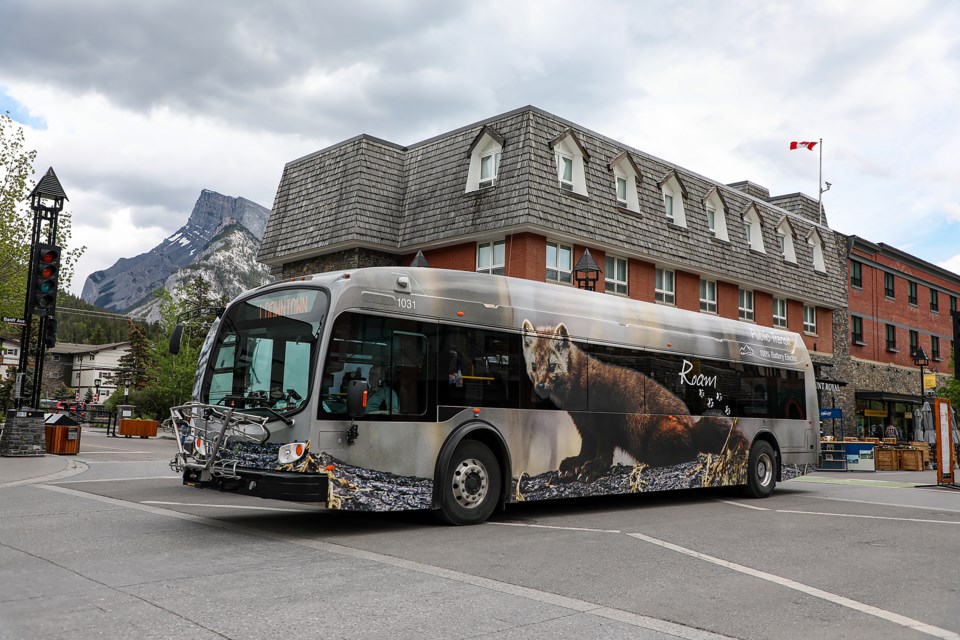BANFF – Efforts rolled out to ease traffic snarls in the Banff townsite over the busy Canada Day long weekend appear to have worked.
Town of Banff officials say advance communications to visitors to expect heavy traffic, and investments in transit proved successful in greatly reducing congestion in town, with traffic delays of 10 minutes at peak times compared to 90 minutes on the May long weekend.
Adrian Field, the municipality’s director of engineering, said there was a high of 28,300 vehicles per day on July 2, which is very similar to entrance counts in 2019 prior to the COVID-19 pandemic.
However, he said fewer people drove across the Bow River bridge to access tourist hotspots such as the gondola and hot springs, and congestion was significantly improved thanks to visitor paid parking and a shift to transit.
“A 21 per cent reduction on Mountain Avenue traffic is the principal cause for congestion improvements – 1,100 fewer vehicles drove up to find full lots at Sulphur in 2022 versus 2019,” he said.
“All our partners – Banff Lake Louise Tourism, Parks Canada, Roam, Pursuit – and the Town of Banff worked extremely hard to get the message across in advance that driving was going to be a miserable experience.”
According to Town of Banff data, Roam ridership on Route 1 to Pursuit’s gondola and Parks' hot springs exceeded 2019 by five per cent.
“Ridership was within 35 riders of the highest daily ridership recorded since the service began in 2008,” said Field, noting the highest was on August 22, 2019, at 3,268 riders.
The intercept parking lot at the train station was full at peak times over the weekend, with vehicles spilling out to areas beyond that.
Still, 50 per cent of vehicles – those without gondola pre-bookings – were turned around at the traffic circle at the parking lot on Sulphur at peak times on Canada Day and forced to drive back down Mountain Ave.
“Moving people to buses really helped,” said Field, noting Banff’s congestion threshold is about 24,000 vehicles.
“But 50 per cent choose to drive past five massive yellow signs that say ‘expect delays and gondola and hot springs parking lots are full’.”
Throughout Banff National Park, most parking lots at day use areas were at capacity by 10 a.m. each morning and remained this way until early evening.
In Lake Louise, Parks Canada estimated the new park-and-ride lot at Lake Louise ski hill was at 70 to 80 per cent capacity over the long weekend.
Officials said two-way traffic volumes on Lake Louise Drive remain higher than in 2021, but lower than pre-pandemic volumes in 2019. Shuttles sold out daily.
Amy Krause, a spokesperson for Lake Louise, Yoho and Kootenay field unit, said flaggers were in place 24 hours at Moraine Lake Road.
“Traffic did not back up onto the Trans-Canada Highway and no roads were closed due to congestion,” said Krause.
“Overall, we saw volumes typical of a long weekend with visitation still strongly tied to weather.”
A Parks Canada-struck expert panel on moving people sustainably throughout Banff National Park is expected to deliver its final report this summer.
The panel has been tasked with making recommendations on a long-term framework for how visitors will get around the Bow Valley and experience Banff National Park, including consideration of new technologies and best practices from around the world.
In addition, the nine-member panel was told to think beyond transportation modes to demand management strategies such as reservation systems, access restrictions, quotas, or timed and paid parking in the park.
The Town of Banff hopes the expert panel addresses a second intercept parking lot the municipality has been lobbying for, as well as introduction of paid parking at the parking lots for the hot springs and gondola to deter people from driving.
“Frankly, at some point, decision-makers need to realize that this isn’t going away. We cannot solve this by trying to move more vehicles through a system that is already full,” said Field.
“In order to accommodate increases in visitation, which is Parks’ mandate, we can’t do it with cars. That just doesn’t apply to Banff. In Lake Louise, the solution is intercept parking, increased shuttles and paid parking. We would like the same thing to happen in Banff.”




